This will be a fast overview, mainly as a photo essay, on the bloomery iron smelt carried out at Wareham on June 14, 2014.
The prototype is Culduthel, Scotland, circa 200 - 400 AD.
The furnace is a 'slag room' type, with a clay shaft built on a withy frame, over a stone base. The general details of the layout were similar to other Late Iron Age / Viking Age furnaces built in the past. The material used was a 50 / 50 mix of dry clay and course sand.
(See the earlier post :
Scottish Dark Ages Iron Smelt )
This smelt was a test / training for the 'Turf to Tools' project being undertaken at the Scottish Sculpture Workshop over August 9 - 25, 2014.
 |
| Clay shaft being built up on a wicker frame, over a stone base chamber. |
 |
| After drying fire - extensive cracking of the shaft (extraction point to right) |
 |
| Equipment set up, at pre-heat phase. |
 |
| Adding the DD-SSW1 analog |
 |
| Bloom mass at initial extraction. Bottom pull was intended, but top extraction was required. |
 |
| After two initial compaction heats, an attempt to cut the bloom. |
 |
| Final Bloom : 5.2 kg (from 28.3 kg dry ore = 18% yield) |
The next day, the bloom was re-heated and compacted using the hydraulic press. After cutting to quarters, the interior surface was spark tested. The observation suggests roughly .6 -.7 carbon content, a good blade making material. (!)
The following will be of more interest to the archaeologicallly inclined:
 |
| The overall remains from the smelt around the furnace. |
 |
| Broken pieces of the furnace, clearly showing the imprint of the wicker interior frame. |
 |
| Furnace opened along the major cracks, showing the slag bowl in place below the tuyere entrance. |
 |
| Main slag bowl removed as two pieces. The tuyere was to the left. |
 |
| Cleaned surface of the rock base. Tuyere was to the top. |
There will be a fuller report to come on making a comparison between the results here, and the remains seen in the archaeology from Culduthel.
Some General Conclusions:
- Some modifications to the layout and construction of the furnace may be necessary to :
- avoid cracking
- conform more closely to the slag pattern at Culduthel
- The analog used proved quite successful, even if the yield was a bit low.
- The general progress of the smelt followed the expected pattern.
- A better system needs to be established for re-heating the bloom for consollodation.
With thanks to the working team:
Kelly, Ron, Heather, Rodger, Neil, Richard.












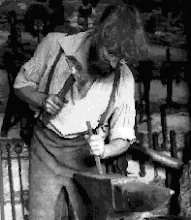

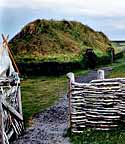
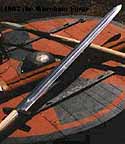
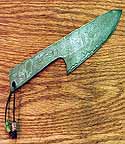
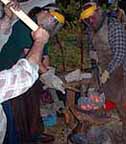














No comments:
Post a Comment